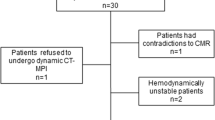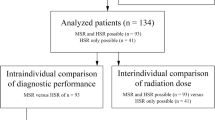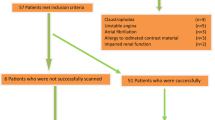Abstract
Coronary CT angiography (CCTA) suffers from a reduced diagnostic accuracy in patients with heavily calcified coronary arteries or prior myocardial revascularisation due to artefacts caused by calcifications and stent material. CT myocardial perfusion imaging (CTMPI) yields high potential for the detection of myocardial ischemia and might help to overcome the above mentioned limitations. We analysed CT single-phase perfusion using high-pitch helical image acquisition technique in patients with prior myocardial revascularisation. Thirty-six patients with an indication for invasive coronary angiography (28 with coronary stents, 2 with coronary artery bypass grafts and 6 with both) were included in this prospective study at two study sites. All patients were examined on a 2nd generation dual-source CT system. Stress CT images were obtained using a prospectively ECG-triggered single-phase high-pitch helical image acquisition technique. During stress the tracer for myocardial perfusion (MP) SPECT imaging was administered. Rest CT images were acquired using prospectively ECG-triggered sequential CT. MP-SPECT imaging and invasive coronary angiography served as standard of reference. In this heavily diseased patient cohort CCTA alone showed a low overall diagnostic accuracy for detection of hemodynamically relevant coronary artery stenosis of only 31% on a per-patient base and 60% on a per-vessel base. Combining CCTA and CTMPI allowed for a significantly higher overall diagnostic accuracy of 78% on a per-patient base and 92% on a per-vessel base (p < 0.001). Mean radiation dose for stress CT scans was 0.9 mSv, mean radiation dose for rest CT scans was 5.0 mSv. In symptomatic patients with known coronary artery disease and prior myocardial revascularization combining CCTA and CTMPI showed significantly higher diagnostic accuracy in detection of hemodynamically significant coronary artery stenosis when compared to CCTA alone.


Similar content being viewed by others
References
Chow BJ et al (2009) Diagnostic accuracy and impact of computed tomographic coronary angiography on utilization of invasive coronary angiography. Circ Cardiovasc Imaging 2(1):16–23
Budoff MJ et al (2008) Diagnostic performance of 64-multidetector row coronary computed tomographic angiography for evaluation of coronary artery stenosis in individuals without known coronary artery disease: results from the prospective multicenter ACCURACY (Assessment by coronary computed tomographic angiography of individuals undergoing invasive coronary angiography) trial. J Am Coll Cardiol 52(21):1724–1732
Deseive S et al (2015) Prospective randomized trial on radiation dose estimates of CT angiography applying iterative image reconstruction: the PROTECTION V study. JACC Cardiovasc Imaging 8(8):888–896
Hausleiter J et al (2009) Prospective Randomized Trial On RadiaTion Dose Estimates of CT AngiOgraphy In PatieNts Scanned With a 100 kV Protocol: the PROTECTION II Study. In Presented at the American College of Cardiology’s Annual Scientific Meeting. Orlando
Hausleiter J et al (2012) Image quality and radiation exposure with prospectively ECG-triggered axial scanning for coronary CT angiography: the multicenter, multivendor, randomized PROTECTION-III study. JACC Cardiovasc Imaging 5(5):484–493
Deseive S et al (2015) Image quality and radiation dose of a prospectively electrocardiography-triggered high-pitch data acquisition strategy for coronary CT angiography: the multicenter, randomized PROTECTION IV study. J Cardiovasc Comput Tomogr 9(4):278–285
Achenbach S et al (2010) Coronary computed tomography angiography with a consistent dose below 1 mSv using prospectively electrocardiogram-triggered high-pitch spiral acquisition. Eur Heart J 31(3):340–346
Shaw LJ et al (2012) Coronary computed tomographic angiography as a gatekeeper to invasive diagnostic and surgical procedures: results from the multicenter CONFIRM (coronary CT angiography evaluation for clinical outcomes: an International multicenter) registry. J Am Coll Cardiol 60(20):2103–2114
Park MJ et al (2011) Coronary CT angiography in patients with high calcium score: evaluation of plaque characteristics and diagnostic accuracy. Int J Cardiovasc Imaging 27(Suppl 1):43–51
Bamberg F et al (2011) Detection of hemodynamically significant coronary artery stenosis: incremental diagnostic value of dynamic CT-based myocardial perfusion imaging. Radiology 206(3):689–698
Blankstein R et al (2009) Adenosine-induced stress myocardial perfusion imaging using dual-source cardiac computed tomography. J Am Coll Cardiol 54(12):1072–1084
Feuchtner G et al (2011) Adenosine stress high-pitch 128-slice dual-source myocardial computed tomography perfusion for imaging of reversible myocardial ischemia: comparison with magnetic resonance imaging. Circ Cardiovasc Imaging 4(5):540–549
Weininger M et al (2012) Adenosine-stress dynamic real-time myocardial perfusion CT and adenosine-stress first-pass dual-energy myocardial perfusion CT for the assessment of acute chest pain: initial results. Eur J Radiol 81(12):3703–3710
George RT et al (2014) Myocardial CT perfusion imaging and SPECT for the diagnosis of coronary artery disease: a head-to-head comparison from the CORE320 multicenter diagnostic performance study. Radiology 272(2):407–416
Rochitte CE et al (2014) Computed tomography angiography and perfusion to assess coronary artery stenosis causing perfusion defects by single photon emission computed tomography: the CORE320 study. Eur Heart J 35(17):1120–1130
Cury RC et al (2015) A randomized, multicenter, multivendor study of myocardial perfusion imaging with regadenoson CT perfusion vs single photon emission CT. J Cardiovasc Comput Tomogrp 103–12(2):e1–e2
Achenbach S et al (2009) High-pitch spiral acquisition: a new scan mode for coronary CT angiography. J Cardiovasc Comput Tomogr 3(2):117–121
Hausleiter J et al (2009) Feasibility of dual-source cardiac CT angiography with high-pitch scan protocols. J Cardiovasc Comput Tomogr 3(4):236–242
Bischoff B et al (2013) Optimal timing for first-pass stress CT myocardial perfusion imaging. Int J Cardiovasc Imaging 29(2):435–442
Westwood ME et al (2013) Systematic review of the accuracy of dual-source cardiac CT for detection of arterial stenosis in difficult to image patient groups. Radiology 267(2):387–395
Sheth T et al (2007) Coronary stent assessability by 64 slice multi-detector computed tomography. Catheter Cardiovasc Interv 69(7):933–938
Vavere AL et al (2011) Coronary artery stenoses: accuracy of 64-detector row CT angiography in segments with mild, moderate, or severe calcification–a subanalysis of the CORE-64 trial. Radiology 261(1):100–108
Schwarz F et al (2013) Myocardial CT perfusion imaging in a large animal model: comparison of dynamic versus single-phase acquisitions. JACC Cardiovasc Imaging 6(12):1229–1238
Bamberg F et al (2010) Dynamic myocardial stress perfusion imaging using fast dual-source CT with alternating table positions: initial experience. Eur Radiol 20(5):1168–1173
Greenwood JP et al (2012) Cardiovascular magnetic resonance and single-photon emission computed tomography for diagnosis of coronary heart disease (CE-MARC): a prospective trial. Lancet 379(9814):453–460
Author information
Authors and Affiliations
Corresponding author
Ethics declarations
Disclosures
Dr. Hausleiter has received research grants and speaker honoraria from Siemens Medical Systems and Abbott Vascular unrelated to the current study. This study was funded by Siemens Healthcare. The company however was not involved in data collection or interpretation.
Conflict of interest
The authors have no conflicts of interest to disclose.
Additional information
Bernhard Bischoff and Simon Deseive contributed equally to the manuscript.
Rights and permissions
About this article
Cite this article
Bischoff, B., Deseive, S., Rampp, M. et al. Myocardial ischemia detection with single-phase CT perfusion in symptomatic patients using high-pitch helical image acquisition technique. Int J Cardiovasc Imaging 33, 569–576 (2017). https://doi.org/10.1007/s10554-016-1020-z
Received:
Accepted:
Published:
Issue Date:
DOI: https://doi.org/10.1007/s10554-016-1020-z




